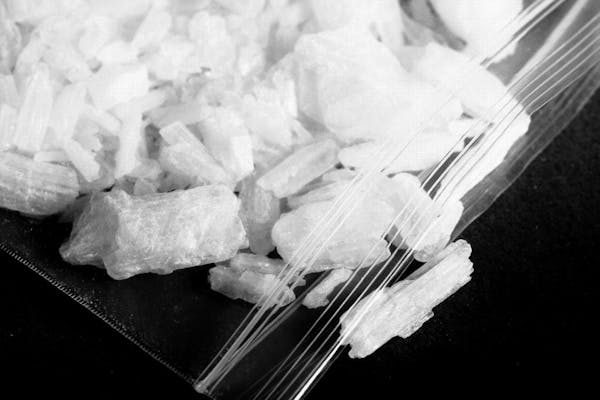Gonzalo Jiminez-Paz Jr. sold meth to a confidential informant by the pound until early March, federal authorities say, before he needed to travel to California to restock his supply.
After he came back to Minnesota, detectives tracked Jiminez-Paz to his apartment on the eighth floor of a 33-story luxury high rise in downtown Minneapolis. Inside, according to a criminal complaint and search warrants, investigators found two guns, 11 phones and two black suitcases full of meth — some 64 pounds in all.
It was the latest big meth bust in what's seemingly been an endless string of them as Minnesota continues to grapple with record amounts of the drug flooding the state. And as more meth is brought in, Minnesota is seeing record numbers of treatment admissions and overdose deaths from the drug.
"I believe that we are in a crisis," said Claire Wilson, a deputy commissioner with the state Department of Human Services (DHS).
More than 2 tons of meth was confiscated in 2018 in Minnesota, according to state and federal law enforcement officials. Nearly 900 pounds of that came from federal investigations, with 2019 seizures aiming to be higher, said Kenneth Solek, assistant special agent in charge of the Drug Enforcement Administration's Minneapolis division.
State drug enforcement teams have seized record amounts of meth 11 years in a row, according to data from the Minnesota Department of Public Safety. Based on early numbers and anecdotal evidence in the field, 2019 will likely be another record year, said Brian Marquart, the statewide gang and drug coordinator.
Violent crimes associated with drug dealing are also rising, Marquart said.
Unlike a decade ago when meth was made in-state, the drug now almost always comes from Mexico, whose cartels have turned Minnesota into a distribution hub for the Upper Midwest.
Last year, a Star Tribune report showed how cartels have flooded the state with a drug that's cheaper and purer than ever before. More than half the 308 federal drug cases filed in Minnesota from 2013 to 2017 were for meth.
Since then, the problem has only gotten worse, Solek said.
About an ounce of the drug — enough to fit into a sugar packet — is about 280 doses. Ten years ago, said U.S. Attorney Erica MacDonald, a case involving 1 to 3 pounds of meth was considered a big seizure.
"Now we're seeing 30 pounds or more all the time," she said.
In September, federal investigators seized a record 191 pounds of the drug in Minnesota.
In February, Kansas state troopers stopped a truck headed to the state hauling three Ford Explorers, one of which had 40 pounds of meth hidden inside, including 28 bags of the drug in the spare tire.
In April, Colorado police stopped a car with California license plates and found 52 pounds of meth.
The driver said he was taking the meth to Minnesota, according to court records.
"This is where [dealers] are comfortable," Solek said. "For whatever reasons, our environments are conducive to what they want to do."
And as more meth has come in, the price has gone down. MacDonald said a pound cost about $20,000 a decade ago. Now it runs $6,000 to $8,000.
A generation ago, when it was being made in garages and backyards, meth carried a reputation as being a backwoods, rural drug.
That's changed, said Dr. Joseph Lee, the medical director for youth services at Hazelden Betty Ford Foundation, the country's largest nonprofit treatment provider.
With cartels selling pure versions of the drug, Lee said he's seeing an increase in use among youth and urban residents.
"It's rebranded itself," Lee said, "and the supply chain is different."
Reversing the trend will take more than law enforcement, said Dana Farley, the alcohol and drug prevention policy director with the Minnesota Department of Health.
"We're missing the big picture on why people are using drugs," Farley said. "This is a misunderstanding of pain … that much of the drug use is a way to deal with pain."
The increased use has taken a massive toll on public health, Wilson said.
In the mid-2000s, when the homegrown meth epidemic was at its peak, the drug accounted for about 16% of treatment admissions. In 2018, that number was 27% — the highest it's ever been, according to DHS data. Only opioids caused more overdose deaths.
About 12 people a year died from meth overdoses in the mid-2000s. Last year, about 161 died from the drug, according to the Minnesota Department of Health — a 1,241% increase.
Wilson, with the DHS, said the number of children removed from homes where there was drug abuse doubled during the past five years.
"We need to get these families help before they're being disrupted," she said.
She said the agency is investing more in treatment while working to remove barriers so that those who need help can get quicker access.
The agency is also trying to pass legislation that would create more treatment providers. DHS also wants to provide housing for people who have finished treatment and are discharged, but often end up homeless, repeating the abuse cycle.
"We have to get a health care system that treats mental health and addiction on par with physical health," she said.

Want to share info with the Star Tribune? How to do it securely

'Safe recovery sites' would offer syringes, naloxone and more to people using drugs. The plan could be in peril.
New Minnesota GOP leaders seek peace with party's anti-establishment wing

Who is Republican Lisa Demuth, Minnesota's first House speaker of color?

